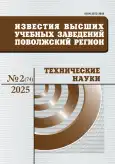Studying the fractal patch antennas in the gigahertz and terahertz frequency ranges
- Authors: Brazhe R.A.1, Lebedev E.Y.1
-
Affiliations:
- Ulyanovsk State Technical University
- Issue: No 2 (2025)
- Pages: 29-40
- Section: ELECTRONICS, MEASURING EQUIPMENT AND RADIO ENGINEERING
- URL: https://journal-vniispk.ru/2072-3059/article/view/308008
- DOI: https://doi.org/10.21685/2072-3059-2025-2-3
- ID: 308008
Cite item
Full Text
Abstract
Background. In recent years, there has been an information boom around fractal antennas designed for wireless communication systems at a wide variety of frequencies. However, there is still no clear opinion among experts on whether such antennas have better characteristics than conventional canonical antennas. In this regard, the purpose of this article is an investigation of fractal patch antennas in modern communication systems of the greatest practical interest at gigahertz and terahertz frequencies. Materials and methods. The paper considers two identical-shaped monopole fractal patch antennas of the “Sierpinski carpet” type: gigahertz and terahertz. The following characteristics of both antennas are investigated: frequency dependences of the scattering matrix, VSWR, input impedance and radiation pattern. It is taken into account that in the terahertz range it is necessary to take into account the fact that plasmon-polaritons with strongly pronounced dispersion properties are excited in the patch. The simulation was carried out in the CST Microwave Studio program separately for the initial triangular canonical antenna and its three fractal iterations. Results. It is shown that the fractalization of an electromagnetic GHz antenna does not provide tangible advantages over the original non-fractal antenna in terms of either the number of operating frequencies or the quality of the radiation pattern, and this fractalization even worsens the situation in a number of parameters. On the contrary, in the case of a plasmon-polariton THZ antenna, due to the dispersion properties of plasmon-polaritons, it is possible to increase both the number of antenna bandwidth, the intensity of the main lobe of the radiation pattern, and its angular width. Conclusion. The often advertised advantages of fractal antennas at frequencies up to gigahertz are actually just a fashion statement. At the same time, in the case of terahertz plasmon-polariton antennas, their fractalization makes it possible to realize new possibilities in terms of multiband and efficient control of characteristics.
Keywords
About the authors
Rudol'f A. Brazhe
Ulyanovsk State Technical University
Author for correspondence.
Email: brazhe@ulstu.ru
Doctor of physical and mathematical sciences, professor, head of the subdepartment of physics
(32 Severniy Venets street, Ulyanovsk, Russia)Egor Yu. Lebedev
Ulyanovsk State Technical University
Email: lebedev.egor@ulsk173.ru
Student
(32 Severniy Venets street, Ulyanovsk, Russia)References
- Al-Zabee A.A.K., Jabbar S.Q., Wang D. Fractal antennas (Study and Review). International Journal of Computers and Technology. 2016;15(13):7387–7400. doi: 10.24297/ijct_v15i13.31
- Boykov I.V., Aykashev P.V. On the issue of analysis and synthesis of fractal antennas. Izvestiya vysshikh uchebnykh zavedeniy. Povolzhskiy region. Tekhnicheskie nauki = University proceedings. Volga region. Engineering sciences. 2017;(4):92–110. (In Russ.). doi: 10.21685/2072-3059-2018-1-8
- Avula R., Rangarao M., Kumari Y. Fractal ultra wide band antenna for 5G applications. International Journal of Recent Technology and Engineering (IJRTE). 2020;7(5S4):215–218.
- Boretti A., Rosa L., Blackledge J., Castelletto S. A preliminary study of a graphene frac-tal Sierpinski antenna. IOP Conf. Series: Materials Science and Engineering. 2020;840:012003. doi: 10.1088/1757–899X/840/1/012003
- Blackledge J., Boretti A., Rosa L., Castelletto S. Fractal graphene patch antennas and the THz communications revolution. IOP Conf. Series: Materials Science and Engineering. 2021;1060:012001. doi: 10.1088/1757–899X/1060/1/012001
- Vdovina G.M. A brief overview of the results of research into new methods of generating, transmitting and receiving oscillations and waves based on fractal geometry methods. Izvestiya vuzov. Prikladnaya nelineynaya dinamika = University proceedings. Ap-plied nonlinear dynamics. 2020;28(1):8–28. (In Russ.). doi: 10.18500/0869-6632-2020- 28-1-8-28
- Smirnov A.V., Fionov A.S., Gorbachev I.A., Shamsutdinova E.S., Kuznetsova I.E., Kolesov V.V. Using additive manufacturing to create broadband antennas with fractal geometry. Radioelektronika = Radioelectronics. 2021;13(4):427–434. (In Russ.). doi: 10.17725/rensit.2021.13.427
- Brazhe R.A., Lebedev E.Yu. Fractal graphene plasmon-polariton patch nanoantenna for near infrared and optical frequency ranges. Izvestiya vysshikh uchebnykh zavedeniy. Povolzhskiy region. Tekhnicheskie nauki = University proceedings. Volga region. Engineering sciences. 2024;(2):98–111. (In Russ.). doi: 10.21685/2072-3059-2024-2-7
- Brazhe R.A., Lebedev E.Yu. Dipole graphene fractal plasmon-polariton patch nanoantenna for IR and optical frequency range. Ra-dioelektronnaya tekhnika: mezhvuzovskiy sb. nauch. tr. = Radioelectronic engineering: interuniversity collected papers. Ul'yanovsk: UlGTU, 2024:30–39. (In Russ.)
- Rosa L., Sun K., Juodkazis S. Sierpinski fractal plasmonic nanoantennas. Physica Status Solidi (RRL). 2011;5(5–6):175–177. doi: 10.1002/pssr.201105136
- Sederberg S., Elezzabi A.Y. Sierpinski fractal plasmonic antenna: A fractal abstraction of the plasmonic bowtie antenna. Optic Express. 2011;19(11):10456–10461. doi: 10.1364/OE.19.010456
- Hussien R.T., Abood D.I. A wideband hybrid plasmonic patch nanoantenna. International Journal of Electronics and Communication Engineering and Technology (IJECET). 2014;5(9):1–8.
- Hansen R.C., Colin R.E. Small Antenna Handbook. John Wiley and Sons, 2011:360.
Supplementary files























